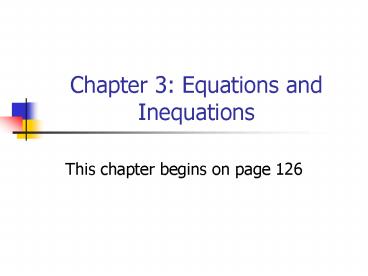Chapter 3: Equations and Inequations - PowerPoint PPT Presentation
1 / 24
Title:
Chapter 3: Equations and Inequations
Description:
Chapter 3: Equations and Inequations This chapter begins on page 126 Chapter 3 Get Ready These concepts need to be reviewed before beginning Chapter 3: Inequality ... – PowerPoint PPT presentation
Number of Views:85
Avg rating:3.0/5.0
Title: Chapter 3: Equations and Inequations
1
Chapter 3 Equations and Inequations
- This chapter begins on page 126
2
Chapter 3 Get Ready
- These concepts need to be reviewed before
beginning Chapter 3 - Inequality statements
- The zero principle
- Use systematic trial and the Cover-up method to
solve equations - Use Algebra tiles and algebraic symbols to solve
equations - Expand Algebraic Expressions
3
3.1 Solve Single Variable Equations 1
- An equation is a statement formed by two
expressions related by an equal sign. - For example, 3x 3 2x 1 is an equation.
4
3.1 2
- To solve an equation means to find the number
that can be substituted for the variable to make
the equation true. - The number that makes the equation true is called
the solution for the equation. - For example, for the equation, x 2 6, the
solution is x 4 because 4 2 6
5
3.1 3
- An equation can be thought of as a balanced
scale. - In order to maintain the balance, whatever is
done to one side must also be done to the other
side in the same step. This creates simpler
equivalent equations. - Equivalent equations will have the same solution.
6
3.1 4
- An inverse operation is a mathematical operation
that undoes a related operation. - For example, addition and subtraction are inverse
operations multiplication and division are also
inverse operations.
7
3.1 5
- Within this section, there are three types of
problems that you will be required to solve. - Solving a multi-step equation
- Solving an equation with fractions
- Solving a word problem by using an equation
8
3.1 6
- Suggested strategy
- When solving equations, I suggest to always check
your answer by substituting the exact value of
the variable directly into the equation. - If both sides yield the same value, then your
solution is correct.
9
3.2 Represent Sets Graphically and Symbolically1
- An inequality is a mathematical statement
relating expressions by using one or more
inequality symbols lt, gt, , or - The symbol means is greater than or equal to
and the symbol means is less than or equal
to.
10
3.2 2
- The following are examples of inequalities
- 4 lt 5
- x 3
- -2 a 6
11
3.2 3
- Set notation is a mathematical statement that
shows an inequality or equation and the set of
numbers to which the variable belongs.
12
3.2 4
- Here is an example of set notation
- x -2 x lt 5, x e R
- The e sign (epsilon in Greek) means belongs to
or is an element of.
13
3.2 5
- Set notation can be expressed in two different
ways - Symbolically as an inequation (for example, x
-2 x lt 5, x e R) and - Graphically as a number line (see page 147)
14
3.2 6
- When representing a set graphically (i.e. with a
number line), an open circle shows that the
number is not included in the set and a closed
circle shows that the number is included in the
set.
15
3.2 7
- Important note in Chapter 1, we learned about
subsets of the real numbers - natural numbers (N)
- whole numbers (W)
- integers (I)
- rational numbers (Q)
- irrational numbers (Q with a bar above it)
16
3.3 Solve Single Variable Inequations 1
- Solving an inequality is similar to solving an
equation - You still isolate the variable on one side of the
inequality by performing inverse operations to
both sides of the inequality.
17
3.3 2
- However, when multiplying or dividing both sides
of an inequation by a negative number, you must
reverse the inequality sign. - This is very important and one must pay close
attention to this fact if one wants to solve
these inequalities properly.
18
3.3 3
- The solution to an inequality is a set of values
of a variable that make the inequality true. - For this reason it may be referred to as the
solution set for the inequality.
19
3.4 Problem Solving with Linear Equations and
Inequalities 1
- Being able to solve problems is an important
skill in your daily life. - One goal of mathematics education is to help you
develop a variety of problem-solving strategies.
20
3.4 2
- There are several strategies available to solve
problems. Here are four of them you may have
already learned - Make a table of values
- Use systematic trial and error
- Looking for a pattern
- Set up and solve an algebraic equation
21
3.4 3
- In this section, you should know how to solve 2
types of word problems - Solving a word problem with the help of an
equation. - Solving a word problem with the help of an
inequation.
22
3.4 4
- To solve a problem using an equation, I suggest
following these five simple steps - Read the problem completely a minimum of three
times. - Choose a variable (typically a letter of the
alphabet) to represent the unknown.
23
3.4 5
- Write an equation. (this is the difficult part)
- Solve the equation algebraically.
- Write a conclusion. This means verifying your
solution by direct substitution into your
equation and stating this solution in a complete
sentence.
24
Summary of Chapter 3
- What subjects did we learn about in Chapter 3?































